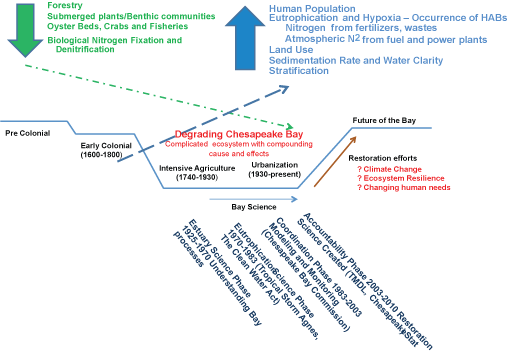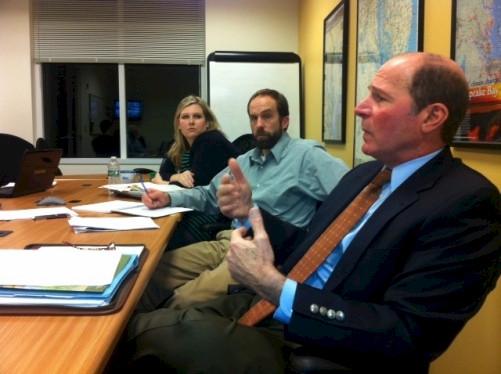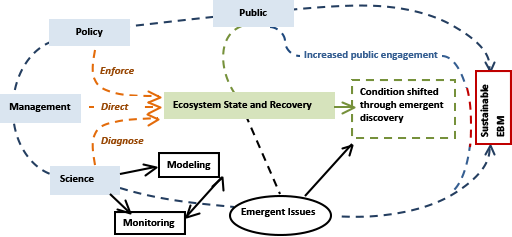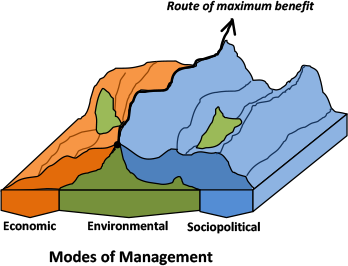The Chesapeake Bay and the Changing Times: Beyond Science and Management
Vanessa Vargas-Nguyen, Alex Fisher, Yini Shangguan ·The Chesapeake Bay is the largest estuary in the United States, defined by a wide range of ecological and physical features. It supports a diverse and dynamic ecosystem which displays not only remarkable evolutionary traits but also a reflection of human history. The Chesapeake Bay and its watershed, once populated with submersed aquatic vegetation (SAV) and covered with forested landscape, have changed with increasing human population and changing needs (Brush, 2008). Increased nutrient inputs and sedimentation lead to eutrophication, hypoxia, loss of SAVs and a shift from a benthic to planktonic population (Figure 1).

It was only in 1972, after the devastating effects of Tropical Storm Agnes, that the degrading condition of the Bay was recognized. From a primarily model system for estuarine research, studies on the Bay shifted to eutrophication processes, to creating models for monitoring, then to restoration (Figure 1). Attempts to reverse eutrophication and anoxia centered on reducing nutrient loading. Recent studies have already correlated recent reduction efforts to decreasing hypoxia and increasing SAVs in some areas (Orth et al 2010 and Murphy et al 2011). However, due to the complicated nature of the Bay, both rapid and slow recovery of functions has been observed (Kemp et al 2005). Climatic factors (Murphy et al 2011) and spatial and temporal variability (Roman et al 2005) should also be considered.
There is no easy way to assess the current state of the Bay, but no matter how the science is interpreted, actions can bring changes and more work needs to be done (N. diPasquale, Bay Program Director, in Bay Barometer 2011-2012). The idea of resilience in the Chesapeake Bay ecosystem has been suggested in the recent Bay Barometer. Measure of this is hard, one has to look in longer terms and assess how the ecosystem responds. It is important to recognize that things are moving rapidly; constant vigilance is needed in light of emerging issues i.e. climate change.

One of the most important developments in the Chesapeake Bay restoration effort is the EPA’s introduction of Total Maximum Daily Load (TMDL). The TMDL program seeks to improve water quality by limiting the flux of pollutants into the waterway through a strict “pollution diet” (US-EPA, 2010). Each jurisdiction develops Watershed Implementation Plans (WIPs) and then the EPA will evaluate its implementation. However, there is really no legal jurisdiction and the EPA can only use leverage to get compliance. Another controversial program is the nutrient trading program which involves the exchange of pollution allocations between sources. The promise is a little over-exaggerated but it does develop creativity in management. The success of these programs depends largely on the community and the participation of its leaders and the people.
The TMDL process is constantly being challenged, mainly because of the apprehension and controversy in the use of the Chesapeake Bay Model. Modeling and monitoring are a big part of the program. It should be considered that although the model is imperfect, it is better than the alternative of having nothing. Models are only as good as the assumptions and the accuracy of the data being used. It’s a good tool to use for making decisions, but should not be confused with the end result. Criticism of the model should not be an excuse to not move forward. The use of additional models has been suggested to help bring confidence; but there is a cost associated with this. Focus is being shifted to monitoring efforts in which emergent issues can be directly observed and/or discovered. The monitoring program is extensive; the biggest challenge is in communicating and connecting live situations with ecosystem-based management (EBM) strategies.
There is a growing need for active coordination between science, policy, and management to design EBM strategies that are adaptable in the face of new issues (Figure 2) and establishing lines of communication and active collaboration that can be accessed in times of stress. To accelerate implementation and increase accountability, the first independent evaluation of the Chesapeake Bay program was conducted by the National Academy of Science and published in 2011 (NAS/NRC, 2011). Scientist should play an active role, not just in examining the science, but also in designing effective management strategies that can be understood and appreciated by all stakeholders. Political dynamics should also be considered. It is important to ensure that tangible benefits can be communicated not only to policy makers, but also to the public.

Designing a management strategy that includes mutual benefits is the key to solving complex problems often associated with emergent issues (Figure 3). There is a big disconnect between taking actions and seeing results. Most people are resistant to regulation and there is difficulty in convincing them of benefits that are not tangible. The reality is that even the best science, best management plans and the most appropriate policy will not be heard and understood by an uncaring ear. It is important to connect the history of Chesapeake Bay and the discovery of emerging issues to the actions of the past, present and future generations. As Director diPasquale quotes, “you don’t value what you don’t know and you don’t protect what you don’t value”. With these changing times, the future of the Bay depends on how many people we can convince to actively engage in caring for the Chesapeake.

References
Bay Barometer 2011-2012: Spotlight on Health and Restoration in the Chesapeake Bay and its Watershed. 2013. http://www.chesapeakebay.net/documents/10-Pg_CBP_Barometer_for_web.pdf
Brush, G. (2008) Historical land use, nitrogen and coastal eutrophication: a paleoecological perspective. Estuaries and Coasts 32: 18-28.
Dennison W. Chesapeake Literacy. UMCES – Integration and Application Network. /blog/chesapeake-literacy/
Kemp, W.M., W. Boynton, J. Adolf, D. Boesch, W. Boicourt, G. Brush, J. Cornwell, T. Fisher, P. Glibert, J. Hagy, L. Harding, E. Houde, D. Kimmel, W.D. Miller, R. I.E. Newell, M. Roman, E. Smith, J.C. Stevenson. (2005) Eutrophication of Chesapeake Bay: Historical trends and ecological interactions. Marine Ecology Progress Series 303: 1-29.
Murphy RR, Kemp WM, Ball WP (2011) Long-Term Trends in Chesapeake Bay Seasonal Hypoxia, Stratification, and Nutrient Loading. Estuaries and Coasts 34(6):1293-1309
National Academy of Science, National Research Council. 2011. Achieving Nutrient and Sediment Reduction Goals in the Chesapeake Bay: An evaluation of Program Strategies and Implementation
Orth, R.J., S.R. Marion, K.A. Moore, D.J. Wilcox. (2010) Eelgrass (Zostera marina L.) in the Chesapeake Bay region of Mid-Atlantic coast of the USA: Challenges in conservation and restoration. Estuaries and Coasts 33: 139-150.
Roman, M.R., X. Zhang, C. McGilliard, W. Boicourt. (2005) Seasonal and annual variability in the spatial patterns of plankton biomass in Chesapeake Bay. Limnol. Oceanogr. 50: 480-492.
United States Environmetal Protection Agency. 2010. Chesapeake Bay TMDL Executive Summary. http://www.epa.gov/reg3wapd/pdf/pdf_chesbay/FinalBayTMDL/BayTMDLExecutiveSummaryFINAL122910_final.pdf
Authors
V.M. Vargas, A. Fisher, and Y. Shangguan
Next Post > Top ten fish and shellfish symbols: Sharks, rays, fish, crabs and lobster larvae
Comments
-
Bill Nuttle 13 years ago
Your post leaves me to wonder whether scientists and managers are measuring and modeling everything that they should to be able to engage stakeholders and the public in a full discussion on conditions in the bay. For example, you mention resilience as a desirable attribute of the ecosystem, but is this something that we can measure or evaluate scientifically. Similarly, climate change and accelerated sea level rise are emerging issues. How are these reflected in the ongoing monitoring and reporting on conditions in the bay? In work I have been involved in in South Florida, aimed at identifying indicators for the coastal marine ecosystem, we found it useful to start by identifying "attributes the people care about." We found that we could line these up pretty well with ecosystem services and then to attributes of the ecosystem that can be measured and monitored. This chain of association also works in reverse to communicate the results of changes captured in a monitoring program in terms of the consequences of these changes to things that people value.
-
M. Brooks 13 years ago
From our conversation last week I got a much better sense of the scope of political and bureaucratic components that are involved in Chesapeake Bay management. It really is so important to show local communities the tangible benefits of management actions so they can build support that can spread throughout the watershed.
-
K Lecorchick 13 years ago
I like how this blog highlights modeling and monitoring as integral parts of Chesapeake Bay management. While the limitations of models are acknowledged, they do have their place. Adding monitoring to the process allows trends to be identified and data to be used to modify or verify the models.
-
Dale Booth 13 years ago
I think it is worth mentioning that though the Chesapeake Bay Model is an imperfect tool, when communicating with the public we can reduce the amount of skepticism surrounding model outputs, if we frame them correctly. As we make predictions and see the real world outcomes the model improves, which means that every year of data we collect gets us a more accurate picture of what we can predict. While the public expects an endpoint with a fixed product, or “right answer”, model outputs are products that are constantly evolving. Ultimately they have no endpoint, because we can always improve the accuracy as we gather more data. However, they can be a useful tool to predict and prevent large scale negative environmental impacts of human activities.
-
Dale Booth 13 years ago
also, AK looks deeply, deeply suspicious in this photo...
-
Melissa 13 years ago
Very nice last paragraph and especially the last sentence, "...the future of the Bay depends on how many people we can convince to actively engage in caring for the Chesapeake."
So true. -
Miaohua 13 years ago
The figure 1 really simple but helpful for us to easily understand the evolution process of Chesapeak Bay and the main problems of that bay. In all, this is an excellent article!
-
Yini Shangguan 13 years ago
I like Bill's comment that by looking into "attributes the people care about", we could then associate with the attributes of the ecosystem that can be measured and monitored. There are some conceptual terms that we are not able to quantify, however, we need quantitative information on how the ecosystem is undergoing the changes impacted by human activities.

